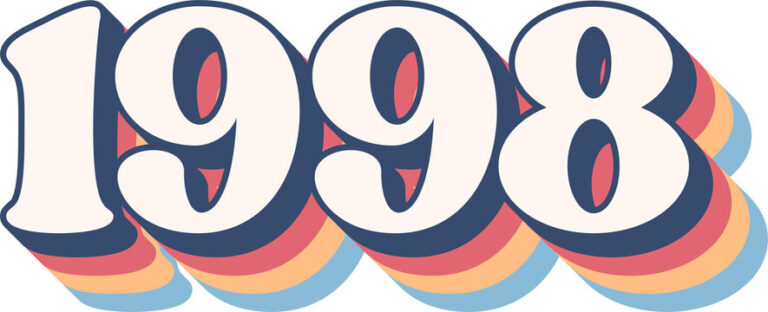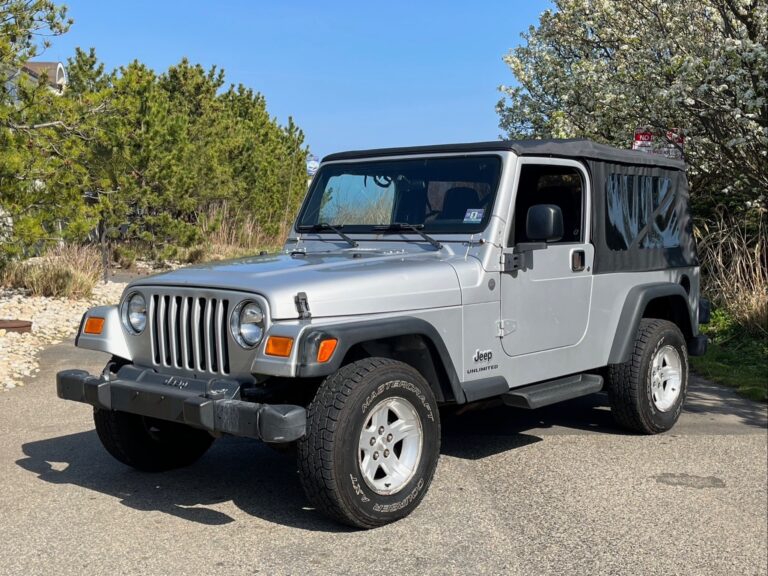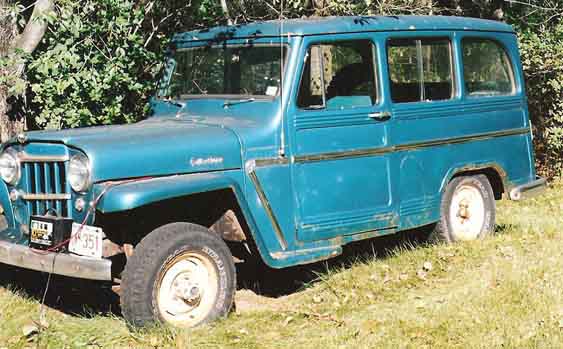1984 Jeep Scrambler For Sale: Your Ultimate Guide to Finding and Owning a Legend
1984 Jeep Scrambler For Sale: Your Ultimate Guide to Finding and Owning a Legend jeeps.truckstrend.com
The rumble of a classic inline-six, the unmistakable silhouette of a long-wheelbase Jeep with a utilitarian pickup bed, and the allure of open-air freedom – these are the hallmarks of the 1984 Jeep Scrambler. More than just a vehicle, the Scrambler (officially known as the CJ-8) is a coveted piece of American automotive history, a rugged workhorse that doubled as an adventurous companion. For enthusiasts and collectors alike, the phrase "1984 Jeep Scrambler For Sale" sparks a thrill, representing an opportunity to own a unique and increasingly rare icon.
This comprehensive guide will delve into everything you need to know about finding, evaluating, and ultimately purchasing a 1984 Jeep Scrambler. From its historical significance to the practicalities of ownership, we’ll equip you with the knowledge to navigate the market and make an informed decision on this extraordinary classic.
1984 Jeep Scrambler For Sale: Your Ultimate Guide to Finding and Owning a Legend
The Allure of the 1984 Jeep Scrambler: A Brief History and Legacy
Introduced in 1981, the Jeep Scrambler, or CJ-8, was AMC’s innovative answer to a demand for a more versatile CJ platform. Building on the popular CJ-7 chassis, the Scrambler featured an extended 103.5-inch wheelbase (compared to the CJ-7’s 93.5 inches), which allowed for a small pickup bed behind the front seats. This unique configuration blended the rugged, go-anywhere capability of a Jeep with the utility of a light-duty truck, making it ideal for everything from ranch work to recreational adventures.
Production of the CJ-8 spanned from 1981 to 1986, making the 1984 model year one of the later iterations before the CJ line was retired in favor of the YJ Wrangler. This later production often means minor refinements were incorporated, yet it retains the pure, unadulterated classic CJ feel that enthusiasts adore. Its relatively short production run and unique design contributed to its rarity, with only around 30,000 units ever produced globally.
The Scrambler’s appeal lies not just in its utility but also in its distinct aesthetic. It offers the classic open-top, removable-door Jeep experience, but with an added layer of practicality that sets it apart from its CJ-7 sibling. Whether seen with a full hardtop, a half-cab, or completely open to the elements, the 1984 Scrambler commands attention and respect, solidifying its status as a highly sought-after collector’s item and a symbol of a bygone era of simple, robust off-roading.
What to Look For: Key Features and Specifications of the 1984 Scrambler
Understanding the core specifications of the 1984 Jeep Scrambler is crucial for any potential buyer. Knowing what came stock can help you identify originality versus modifications, and understand the potential performance characteristics.

- Engine Options: The primary engine for the 1984 Scrambler was the robust 4.2-liter (258 cubic inch) AMC inline-six-cylinder engine. Known for its torque and durability, this carbureted engine is a workhorse, though its emissions controls (especially in California models) can sometimes be a source of frustration for modern drivers. A less common option was the 2.5-liter (150 cubic inch) four-cylinder engine, primarily found in export models or those designed for better fuel economy. While a 5.0-liter (304 cubic inch) V8 was available in earlier CJ models, it was not a factory option for the 1984 Scrambler, so any V8 you encounter will be an aftermarket conversion.
- Transmission: Buyers could choose between a manual or automatic transmission.
- Manual: Common manual transmissions included the Borg-Warner T4 (4-speed) and T5 (5-speed). Later in the CJ-8’s life, some models received the Peugeot BA10/5 5-speed manual, though it’s less common in 1984 models.
- Automatic: The sturdy Chrysler Torqueflite 999 (TF999) 3-speed automatic was a popular and reliable choice.

- Transfer Case: All Scramblers came equipped with the legendary Dana 300 part-time four-wheel-drive transfer case. Renowned for its strength and versatility, the Dana 300 offers 2HI, 4HI, and 4LO modes, making it an excellent foundation for off-road capability.
- Axles: Typically, a Dana 30 was found in the front, and an AMC Model 20 in the rear. While generally robust, the AMC 20 rear axle is known for having a weak two-piece axle shaft design, which many owners upgrade to a one-piece shaft for increased durability, especially if serious off-roading is planned.
- Exterior Features: The Scrambler’s defining feature is its extended wheelbase and pickup bed. It was available with various top configurations, including a full soft top, a full hardtop, or a rarer half-cab hardtop (which essentially made it a two-seater pickup). Removable doors and a fold-down windshield are standard CJ features.
- Interior: True to its utilitarian roots, the Scrambler’s interior is basic but functional. Expect vinyl seats, a simple dashboard with analog gauges, and minimal creature comforts. This simplicity, however, is part of its charm and ease of maintenance.

The Hunt Begins: Navigating the Market for a 1984 Jeep Scrambler For Sale
Finding a 1984 Jeep Scrambler for sale requires patience, persistence, and knowing where to look. Unlike modern vehicles, these classics aren’t found on every corner.
- Online Marketplaces: Websites like eBay Motors, Craigslist, Facebook Marketplace, and specialized classic car sites (e.g., Hemmings, ClassicCars.com) are common starting points. Auction sites like Bring a Trailer have also become popular for higher-end or fully restored examples.
- Specialized Jeep Forums & Clubs: Online forums dedicated to classic Jeeps or CJ models are invaluable resources. Members often list vehicles for sale, and you can tap into a community for advice and leads. Local Jeep clubs can also be a great source for word-of-mouth opportunities.
- Classic Car Dealerships & Auctions: Some dealerships specialize in classic vehicles and may have Scramblers in their inventory. Live auctions can offer a wide selection, but require quick decision-making and a thorough understanding of the vehicle’s condition beforehand.
- Word-of-Mouth: Sometimes the best deals come from unexpected places. Let friends, family, and local mechanics know you’re looking.
Setting Your Budget & Understanding Conditions:
The price of a 1984 Scrambler varies dramatically based on its condition, originality, and any modifications. Be prepared for a wide range:
- Project Vehicle: These are typically the most affordable, often riddled with rust, mechanical issues, or incomplete. They require significant time, money, and expertise to restore. Expect prices from $5,000 – $15,000.
- Driver Quality: These Scramblers run and drive, but have cosmetic flaws, minor mechanical issues, or show significant wear. They can be enjoyed immediately but will likely need ongoing work. Prices range from $15,000 – $30,000.
- Restored/Restomod: These have undergone professional restoration, either to original specifications or with modern upgrades (restomod). They often look fantastic and perform well but come with a premium price tag. Prices can range from $30,000 – $60,000+.
- Concours/Show Quality: These are meticulously restored to original factory specifications or are exceptionally well-preserved "survivor" vehicles. They are rare and command top dollar. Prices often exceed $60,000, potentially reaching six figures for pristine examples.
Crucial Considerations Before You Buy: Inspection and Due Diligence
Buying a classic vehicle like a Scrambler is not like buying a new car. A thorough inspection is paramount.
- Rust, Rust, Rust: This is the #1 enemy of the CJ-8. Pay meticulous attention to:
- Frame: Check for cracks, patches, and severe rust, especially near body mounts, spring hangers, and the rear cross member.
- Body: Inspect floor pans (especially under the pedals and seats), rocker panels, quarter panels (especially behind the rear wheels), tailgate, and the bed floor. Rust in these areas can be extensive and costly to repair.
- Body Mounts: Ensure the body is properly seated on the frame and mounts aren’t rusted through.
- Mechanical Check:
- Engine: Listen for strange noises, look for excessive smoke (blue for oil, white for coolant, black for fuel), and check for fluid leaks. Examine the carburetor for proper function (a common issue with the 258ci).
- Transmission & Transfer Case: Check for smooth shifting, grinding, and leaks. Engage 4WD to ensure the transfer case works correctly.
- Axles: Look for leaks at the differential covers and axle seals.
- Steering & Suspension: Check for excessive play in the steering wheel. Inspect leaf springs, shocks, and bushings for wear or damage.
- Brakes: Test the brakes for proper function, pulling, or spongy pedal feel.
- Electrical System: Test all lights, gauges, wipers, and the heater. Original wiring can be brittle and prone to issues after decades of use. Look for signs of amateur wiring jobs.
- Undercarriage: Inspect for signs of off-road abuse, such as dented skid plates, bent tie rods, or damaged exhaust.
- Documentation: Always ask for the title and ensure the VIN matches. Any service records or history of previous ownership can add value and provide insight into the vehicle’s past.
- Pre-Purchase Inspection (PPI): If you’re serious about a vehicle, especially one out of your local area, hire a qualified mechanic specializing in classic Jeeps or 4x4s to perform a comprehensive PPI. This small investment can save you thousands down the line.
Understanding Valuation: What Determines the Price of a 1984 Scrambler?
Several factors beyond basic condition influence the market value of a 1984 Jeep Scrambler:
- Rust-Free Status: A truly rust-free Scrambler, especially from a dry climate, commands a significant premium. Repairing extensive rust can easily exceed the vehicle’s initial purchase price.
- Originality vs. Modification: Generally, highly original, unmolested examples with matching numbers (where applicable) are more valuable to collectors. However, well-executed and desirable modifications (e.g., engine swaps, axle upgrades, lift kits) can also increase value if done professionally and tastefully. Poorly done or extreme modifications can detract.
- Engine & Transmission Type: The 4.2L I6 with a manual transmission is often the most desirable combination for enthusiasts. V8 conversions can be valued differently depending on the engine choice and quality of the swap.
- Accessories & Options: Factory hardtops (especially half-cabs), power steering, air conditioning (rare but existing), and unique factory paint schemes can add to the value. Aftermarket accessories like winches, premium wheels, or custom interiors can add or detract value depending on quality and buyer preference.
- Geographic Location: Scramblers from dry, arid climates (e.g., Southwest US) tend to be in much better condition regarding rust than those from rust-belt states.
- Completeness: Missing parts, especially unique body components like the bed or tailgate, can significantly impact value due to their scarcity.
Ownership and Maintenance: Life with a Classic Scrambler
Owning a 1984 Jeep Scrambler is a rewarding experience, but it comes with the responsibilities of maintaining a classic vehicle.
- Common Issues: Beyond rust, the 4.2L engine’s carburetor can be finicky, leading many owners to convert to fuel injection (e.g., Howell TBI or affordable aftermarket kits) for improved reliability and performance. Electrical gremlins, worn steering components leading to play, and general aging of rubber and plastic components are also common.
- Parts Availability: Mechanical parts (engine, transmission, transfer case, axles) are generally good, as they were shared with other CJ models and even some early YJ Wranglers. Aftermarket support for these components is robust. Body parts, especially for the unique Scrambler bed, tailgate, and rear quarter panels, can be much harder to find new and often require sourcing used or specialized reproduction panels.
- Community Support: The classic Jeep community is incredibly strong and helpful. Online forums (e.g., JeepForum.com, CJ-8.com), Facebook groups, and local clubs are excellent resources for advice, parts sourcing, and technical assistance.
- Insurance: Consider classic car insurance. Policies from companies like Hagerty or Grundy often offer better coverage, lower premiums, and agreed-upon value policies compared to standard auto insurance.
- Future Value: Well-maintained and original 1984 Jeep Scramblers have shown consistent appreciation in value over the years due to their rarity and iconic status. They represent a solid investment for enthusiasts.
Practical Advice and Actionable Insights
- Define Your Purpose: Are you looking for a daily driver, an off-road beast, a show truck, or a weekend cruiser? Your intended use will heavily influence the condition and modifications you should look for.
- Budget Beyond the Purchase Price: Factor in costs for initial maintenance, potential repairs, registration, insurance, and any desired upgrades. A project Scrambler will quickly eat up more than its initial purchase price in restoration costs.
- Learn the Basics: Familiarize yourself with the common issues of CJ-8s. Even if you’re not doing the work yourself, understanding the terminology and potential problems will help you communicate with mechanics and evaluate vehicles.
- Don’t Rush: The right Scrambler will come along. Don’t feel pressured to buy the first one you see, especially if it doesn’t meet your criteria or raises red flags.
- Leverage the Community: Join forums and groups before you buy. Ask questions, learn from others’ experiences, and you might even find a lead on a vehicle for sale.
1984 Jeep Scrambler For Sale: Estimated Price Guide
Please note: These are estimated ranges and actual prices can vary significantly based on specific condition, location, seller, and market demand.
| Condition Category | Estimated Price Range (USD) | Key Factors Influencing Price





